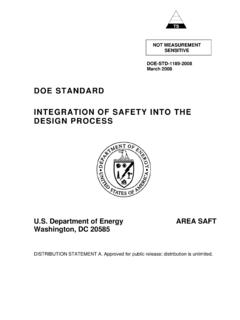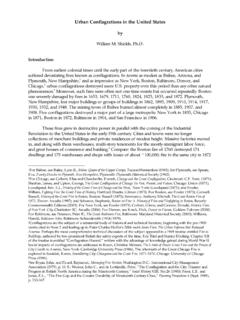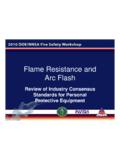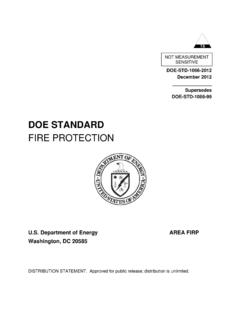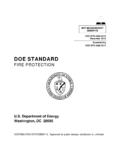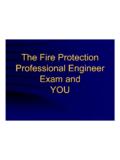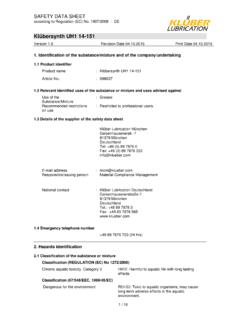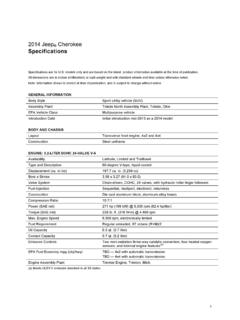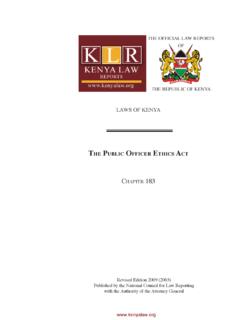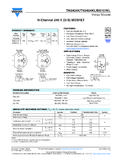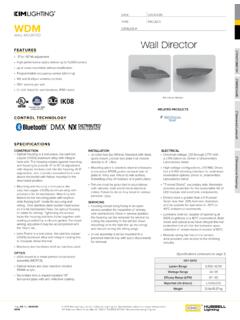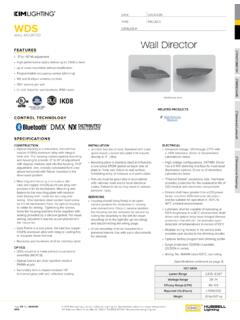Transcription of SFPE Equation Sheet [KL 10-19-2015]
1 1 Heat Flux 36 IIU (Illinois Institute) Water Supply Equation 2 Emissivity 3 Blast Wave Energy 37 Door Opening Forces 4 TNT Mass Equivalent 38 Thrust Blocks 5 BLEVE 39 Reaction Forces in Nozzles 6 Fireball 40 Rate of Heat Release 7 Pool Fires Mass Loss Rate 41 Heat Detector RTI. 8 Total Heat Generated 42 Furnace Test Correction Factor 9 Energy Absorbed 43 Tied Fire Walls 10 Heat Release Time growth 44 Equivalent Thickness of Wall Material with Voids 11 Lower Flammable Limit 45 Wind Pressure 12 Exit sign visibility 46 Stairwell Pressurization 13 Compartment Fires 47 Stairwell Pressurization Height Limitation 14 McCaffrey Flashover Heat Release equations 48 Liquid Fuel Flame Height 14A Pre-Flashover Compartment Temps Natural 49 Plume Centerline Temperature Rise Ventilation 49A Temperature of Smoke in a Plume 14B Pre-Flashover Compartment Temps Natural 50 Plume Radius to point where temperature rise Ventilation @ STP has declined to TO. 14C Pre-Flashover Compartment Temps Forced 51 Plume Centerline Velocity Ventilation 52 Weak Plume Driven Temperature of Ceiling Jet 14D Flashover Reference 52A Weak Plume Driven Velocity of Ceiling Jet 15 Virtual Origin of Pool Fire 53 Height of 1st Indication of Smoke for Steady Fires 15A Virtual Origin of Other Fire Types 54 Height of First Indication of Smoke for Unsteady 16 Peak Heat Release Rate (or Growing) Fires 17 Pipe Schedule Correction Factor 55 Height of Flame Tip 18 Hydrant Flow Test 56 Mass Flow Rate if H > zl 19 Sprinkler System K-Factor to balance pressures 57 Volumetric Flow Rate (NOT additive use highest pressure of any single branch 58 Density of Smoke line)
2 59 Average Temperature of Fire Plume 20 Sprinkler Head flow using Sprinkler K-Factor 60 Average Mass Flow Rate of Fire Plume 21 Sprinkler Flow Normal Pressure 61 Maximum Flow Rate to Avoid Plugholing 22 Sprinkler Flow Velocity Pressure 62 Required Opposed Airflow for Smoke Control 23 Conservation Equation /Bernoulli Equation 63 Limiting Average Velocity through Communicating 24 Darcy-Weisbach Equation (foam concentrate, Space antifreeze >40 gal, & water mist) 64 Vented Fire Smoke Layer Temperature Change 25 Piping Loops 65 Atrium ASET. 26 Pump Caviation 66 Smoke Flow Across an Opening /Pressurization 27 Water Hammer 67 Stack Effect/Bouyancy 28 Pump Affinity Laws 68 Critical Airflow Velocity for Smoke Control 29 Fire Pump Total Head 69 Minimum Recommended Vent Area for Venting 30 Pump Brake Horsepower) Remember, typical psi is of Low-strength Enclosures from Gases, Gas 65% @ 150% capacity or 55% @ 160% capacity. Mixtures and Mists 31 Velocity Head 70 Beam or Column Substitution 31A Net Positive Suction Head (NPSH_) 71 Venting One End of Elongated Enclosure 31B Diesel Fuel Tank Capacity 72 Minimum Pred for Non-Relieving Wall Construction 32 Fire Pump Controller Operation 73 Vent Area for High-Strength Enclosures 33 Sprinkler Flow Pressure Loss Hazen-Williams 74 Effects of Vent Ducts (Non-cubical Vessels).
3 33A Pressure Due to Elevation 75 Effects of Vent Ducts (Cubical Vessels). 34 ISO Water Supply Equation 76 Venting of Deflagrations of Dusts and Hybrid 35 ISU (Iowa State) Water Supply Equation Mixtures 77 Partial Volume Deflagrations 78 Column Resistive Rating 79 Vent Area Threshold Mass 80 Time Value of Money 1 Heat Flux )+8* mass of fuel (kg). (FPH 3-156; HFPE 3-279) ; Distance of center of fireball to target (m). " = /(4 ). " Heat flux on target perpendicular to radius from 7 Pool Fires Mass Loss Rate point source (NFPA ; HFPE 3-37). Radiative heat release from fire (20 to 30% of ) " = < ". (1 = >?@A ). r R Distance from plume center at h/2 to target large pool burning rate NEED TO LOOK AT HPFE 1-4 FOR CONFIGURATION <. ". Mass loss rate for an infinite pool diameter (SHAPE) FACTORS Table pg 1-77 & Appendix pg A-45 BC Extinction absorption coefficient (HFPE pg 3-37 or NFPA 92 Table ). 2 Emissivity (HFPE 3-307; FPH 2-11) 8 Total Heat Generated " = T4 (HFPE 1-96).
4 " flame emissive power kW/m2 D = E G . = for a blackbody D Total Heat Generated = x 10-12 (kW/m2K4 - Stefan-Boltzman Constant) E Radiative fraction of combustion energy ( calculated . from HFPE pg 3-142 E = I = (1 E JK68LM,68 ). T is in Kelvin D. 3 Blast Wave Energy ' Mass burning rate of fuel Hc Heat of combustion (HFPE 1-94). = D /4 r2. (FPH 2-95). heat flux, r meters from point source = . E Blast wave energy (kJ). A Yield (Fraction of available combustion energy participating in blast wave generation. Conservative 9 Energy Absorbed value is ) = N " O P. Hc C Theoretical net heat of combustion (kJ/kg) E Energy absorbed mF M Mass of flammable vapor released (kg) Emissivity Heat flux 4 TNT Mass Equivalent A Exposed area (FPH 2-94) t time _ = 4500. WTNT Equivalent weight of TNT in kg 10 Heat Release Time growth E Blast wave energy in kJ (NFPA & Table (b); HFPE 4-13; FPH 18- 62). 1055. (P) = Q S P 5 BLEVE. (FPH 6-171) PR. = (! !# ) (P) Total heat release rate at time t (kW).)
5 E Blast wave energy P Time in seconds m Mass of liquid in vessel PR Time for a fire to grow from first appearance of flame Ur Internal energy (per unit mass) of liquid at rupture to 1,055 kW (1,000 Btu/s) (NFPA 92 Table (b);. Ua Internal energy (per unit mass) of vapor after expansion HFPE 4-13; FPH 18-62). Common PR = 75 for ultrafast fires, 150 for fast fires, 300. 6 Fireball for medium fires, and 600 for slow fires (FPH 18-86; HFPE 3-311).. /. $%#& = )*+,- 11 Lower Flammable Limit 01 = 56#..// (HFPE 2-197; FPH 3-126). %#&. ". = 828 )+8*. 9.::. /; TUT = 5V V LFL lower flammable limit $%#& Maximum diameter of fireball (m). VLFL Vapor pressure of liquid @ its LFL, psia )*+,- Mass of fluid (kg). TUT = 5V V 01 Rise of center of fireball above tank (m). 56# Fuel vapor volume (m3). LFL lower flammable limit %#&. ". VLFL Vapor pressure of liquid @ its LFL, kPa Peak thermal radiation from fireball (kW/m2). TUT = 1005 W tp = (rc/B)(d/2)2. LFL lower flammable limit r density of compartment surface (kg/m3).
6 V Vapor pressure of liquid @ its LFL @ ambient pressure c specific heat of compartment surface material (kJ/m-K). P Ambient pressure B thermal conductivity of compartmt surface (kW/ m-K). Generally as T LFL UFL and as p LFL const UFL . d thickness of compartment surface (m). 14A Pre-Flashover Compartment Temps Natural 12 Exit sign visibility Ventilation (HFPE 2-53). [\ 55 = 8 ]^ _`a P = `PP`ca =d`P e`ac (FPH 3-151; HFPE 3-209).. >/. [\ 5 = 3 ]^ _`a P =]_=fP`ca =d`P e`ac /. ? O D. R = 480 p r p r [\ extinction coefficient (m-1) (HFPE 2-64) ma(f1 q< < Ol )m l ma(f1 q< Ol )m l V visibility (m) Tg = R <. g Tg Upper gas temperature rise above ambient (Kelvin). = = > iV R Upper gas temperature (Kelvin). gh Bouguer's Law g = 10>AV < Ambient gas temperature (Kelvin). Total Heat Release Rate (kW). gh $ = [\ $\ = $5L /A hk Effective heat transfer coefficient (thermal inertia). $% = $5L / M hk = (kcr/t) (Note: c,r may not be same ) (kW/m*Kelvin). [\ = [% m O D Total area of compartment enclosing surfaces (m2).]]]
7 J Intensity of Light through Pathlength (L) of Smoke Ol Area of opening (m2). j9 Intensity of Incident Monochromatic Light l Height of opening (m). $ Optical Density per Meter a = m/s2. $\ Specific Optical Density (dimensionless) f1 = *K (specific heat). $% Mass Optical Density (m2/g) HFPE 2-264 Table < = kg/m3 (density). 5L Volume of space being filled with smoke (m3) < = 295 K (Kelvin). A Area of Sample being burned (m2). [\ extinction coefficient (m-1) 14B Pre-Flashover Compartment Temps Natural [% m extinction coefficient per unit mass ~ m2/g Ventilation @ STP. (FPH 3-151; HFPE 3-209). (flaming fire of wood and plastics use unless other info given) OR ~ m2/g (pyrolysis fire) R = ( ).//. M amount of material that burns (grams) ? O D Ol m l m mass concentration of smoke aerosol Tg = Tg - T . Tg Upper gas temperature rise above ambient (Kelvin). 13 Compartment Fires R Upper gas temperature (Kelvin). (HFPE 3-195) < Ambient gas temperature (Kelvin).]]
8 Use Law's formula to calculate post-flashover Total Heat Release Rate (kW). compartment fire temperatures (HFPE pg 3-216) ? Effective heat transfer coefficient ((kW/m)/Kelvin). O D Total area of compartment enclosing surfaces (m2). 14 McCaffrey Flashover Heat Release equations Ol Area of opening (m2). (HFPE 3-219) l Height of opening (m). )* = 610( ? O D Ol m l )./ )* Heat Release rate required for flashover (kW) 14C Pre-Flashover Compartment Temps Forced ? Effective heat transfer coefficient ((kW/m)/K) Ventilation O D Total area of compartment surfaces (m2) (HFPE pg 3-210). Ol Area of opening (m2) R . 9.: ? O D. l Height of opening (m) = Q S Q S. ? < R < f1 R f1. ? = where time of exposure (t) > thermal penetration Tg = Tg - T . n time (tp) Tg Upper gas temperature rise above ambient (Kelvin). ? = (krc/t) where t <= tp R Upper gas temperature (Kelvin). B Thermal conductivity of wall material HFPE A-28-33 < Ambient gas temperature (Kelvin). o Thickness Total Heat Release Rate (kW).
9 ? Effective heat transfer coefficient ((kW/m)/Kelvin). O D Total area of compartment enclosing surfaces (m2). | m `P^P. (FPH pgs 15-40 through 15-45). f1 specific heat of gas (kJ/kg-K). R compartment mass ventilation rate (kg/s) f constant based upon hydrant outlet (FPH 15-45 Table R is (m3/s)( kg/m3) {5000 cfm ~ m3/s}. | diameter of opening (inches). ). 14D Predicting Flashover Reference pitot velocity pressure of water exiting hydrant (psi). (HFPE 3-217; FPH 2-56, 3-128, & 3-150). Solve equations above for Tg 600oC. Flashover occurs, R 600oC and " 20kW/m2. 19 Sprinkler System K-Factor to balance pressures (FPH 15-48; HFPE 4-75; NFPA ). MJM#*. MJM#* =. 15 Virtual Origin of Pool Fire m 8 +, 8- MJM#* = #KL}. t #KL} t _ #KL}K MJM#* . sJ = $ t u (HFPE 2-10; FPH 3-155). Sprinkler System K-factor MJM#* Total System Flow (gpm). $ diameter of fire source(m). Z0 Virtual Origin 8 +, 8- Required System Pressure (psi) (NOT additive . Total heat release rate (kW) use highest pressure of any single branch line).
10 15A Virtual Origin of Other Fire Types 20 Flow Through Nozzles K-Factor L u . (FPH 15-46; HFPE 4-75). = m . (HFPE pg 2-11; FPH pg 3-155). sJ = T . sJ Virtual Origin = T Flame Height (m) = /u (NFPA 92 ) d nominal diameter of opening (inches). T Flame Height (m) = D /u " $ HFPE 2 " 4 . Or c coefficient of friction (FPH 15-45) (NOT the Hazen- Williams Coeficient). Total heat release rate (kW).. System Flow (gpm). System Pressure (psi). 16 Peak Heat Release Rate 21 Sprinkler Flow Normal Pressure = " O . (HFPE 2-11; NFPA 92B Annex B). Peak Heat Release Rate (kW). (NFPA 13 ). WK = WM W6. WK Normal pressure " mass loss rate per unit area of fuel from HFPE 3-134. WM Total pressure O Area (m2). W6 Velocity pressure or HFPE 3-37 (kg/s). Heat of Combustion (kJ/kg). 22 Sprinkler Flow Velocity Pressure I. |~ (NFPA 13 ). 17 Pipe Schedule Correction Factor W6 =. |#LM+#* ~. : W6 Velocity pressure (psi). (NFPA 13 & ). [^ =fP`^c ]zfP^ { Flow prior to orifice (gpm).}
